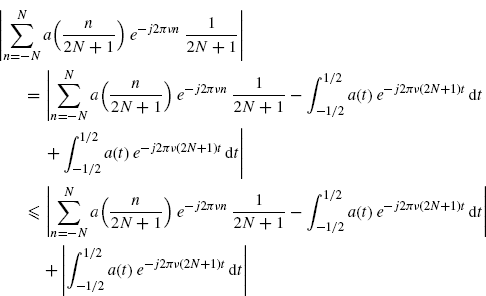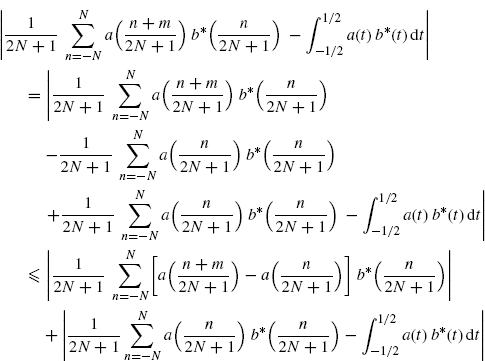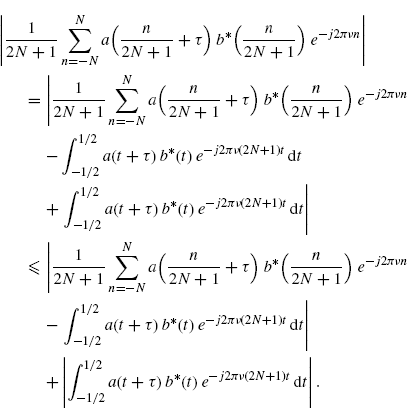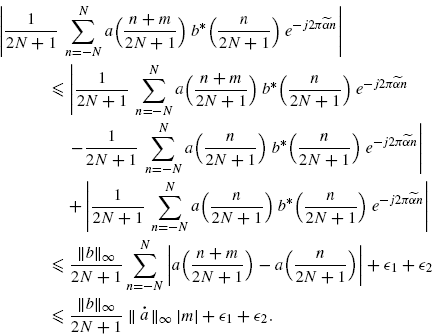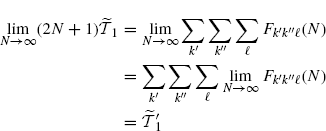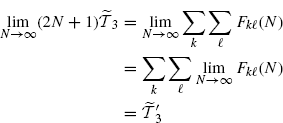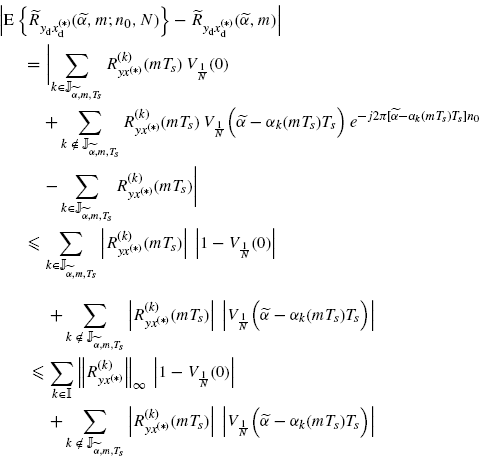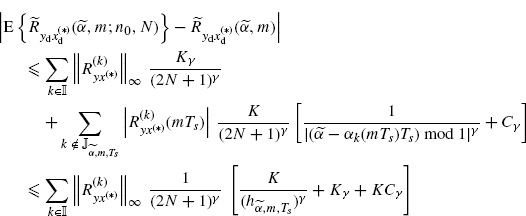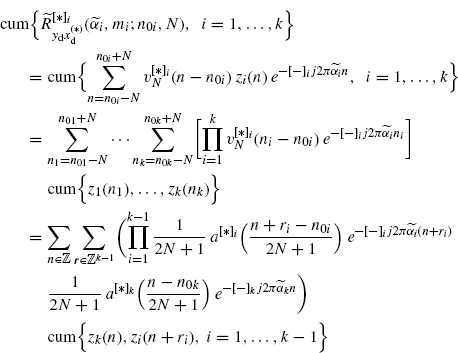3.10 Proofs for Section 2.6.2 “Asymptotic Results as N→ ∞”
Lemma 3.10.1 Let ![]() be given by (2.184) with a(t) as in Assumption 2.4.5. It results that
be given by (2.184) with a(t) as in Assumption 2.4.5. It results that
Proof: Since a(t) has finite support [− 1/2, 1/2), to prove (3.155) is equivalent to prove that
Let us consider first the case ![]() .
.
Since a(t) is Riemann integrable (Assumption 2.4.5), we have
(3.157) 
Let us consider now the case ![]() , ν > 0.
, ν > 0.
For every ![]() the function
the function ![]() is Riemann integrable and we have
is Riemann integrable and we have
that is, ∀![]() 1 > 0
1 > 0 ![]() such that for
such that for ![]()
(not necessarily uniformly with respect to ![]() ).
).
Since ![]() , the Riemann-Lebesgue theorem (Champeney 1990, Chapter 3) can be applied. Thus,
, the Riemann-Lebesgue theorem (Champeney 1990, Chapter 3) can be applied. Thus,
(3.160) 
that is, ∀![]() 2 > 0
2 > 0 ![]() such that for
such that for ![]()
Let us consider, now, the following inequality:
Since ν > 0, take ![]() 2 arbitrarily small in (3.158), and define
2 arbitrarily small in (3.158), and define ![]() such that
such that ![]() . Fix
. Fix ![]() in (3.158) and take
in (3.158) and take ![]() 1 arbitrarily small and
1 arbitrarily small and ![]() in (3.159). Let
in (3.159). Let ![]() and
and ![]() . It results in
. It results in ![]() in (3.161) and
in (3.161) and ![]() in (3.159). Thus, the right-hand side of (3.162) is bounded by
in (3.159). Thus, the right-hand side of (3.162) is bounded by ![]() 1 +
1 + ![]() 2 with
2 with ![]() 1 and
1 and ![]() 2 arbitrarily small, which proves (3.156) for ν > 0. Finally, note that the result holds for every non-integer ν since the function
2 arbitrarily small, which proves (3.156) for ν > 0. Finally, note that the result holds for every non-integer ν since the function ![]() is periodic in ν with period 1.
is periodic in ν with period 1.
As a final remark, note that Lemma 3.10.1 can also be obtained as corollary of the following Lemma 3.10.2 with b(t) = rect(t), m = 0. To prove Lemma 3.10.1, however, the assumption ![]() bounded is not used.
bounded is not used.
![]()
Lemma 3.10.2 Let a(t) be bounded and continuous in (− 1/2, 1/2) except, possibly, at t = ± 1/2, derivable almost-everywhere with bounded derivative, and let ![]() . Let both a(t) and b(t) be with finite support [− 1/2, 1/2], and such that for every τ
. Let both a(t) and b(t) be with finite support [− 1/2, 1/2], and such that for every τ ![]() [− 1, 1] the function a(t + τ)b*(t) is Riemann integrable in [− 1/2, 1/2]. We have
[− 1, 1] the function a(t + τ)b*(t) is Riemann integrable in [− 1/2, 1/2]. We have
Proof: The function b(t) has finite support [− 1/2, 1/2]. Thus the sum in (3.163) can be extended from −N to N.
![]() . The following inequality holds
. The following inequality holds
As regards the first term in the right-hand side of (3.164), observe that the first-order derivative ![]() exists a.e. and is bounded (Assumption 2.4.5). Therefore, for almost all t1 and t2 there exists
exists a.e. and is bounded (Assumption 2.4.5). Therefore, for almost all t1 and t2 there exists ![]() such that
such that ![]() and, hence,
and, hence, ![]() . Consequently,
. Consequently,
As regards the second term in the right-hand side of (3.164), observe that the function a(t + τ)b*(t) is Riemann integrable in [− 1/2, 1/2] so that, for τ = 0,
(3.166) 
That is, ∀![]() > 0 ∃ N
> 0 ∃ N![]() such that for N > N
such that for N > N![]() one has
one has
(3.167) 
Therefore, the right-hand side of (3.164) is bounded by
which can be made arbitrarily small, provided that N is sufficiently large.
This proves (3.163) for ![]() .
.
![]() . For every
. For every ![]() ,
, ![]() , the function
, the function ![]() is Riemann integrable in [− 1/2, 1/2]. Thus
is Riemann integrable in [− 1/2, 1/2]. Thus
(3.168) 
that is, ∀![]() 1 > 0
1 > 0 ![]() such that for
such that for ![]()
not necessarily uniformly with respect to ![]() and τ. Since
and τ. Since ![]() and
and ![]() , it results in
, it results in ![]() . Thus, the Riemann-Lebesgue theorem (Champeney 1990, Section 3.7 can be applied:
. Thus, the Riemann-Lebesgue theorem (Champeney 1990, Section 3.7 can be applied:
(3.170) 
that is, ∀![]() 2 > 0
2 > 0 ![]() such that for
such that for ![]()
not necessarily uniformly with respect to τ.
For arbitrarily small ![]() 2, fix
2, fix ![]() so that (3.171) holds. Once
so that (3.171) holds. Once ![]() is fixed, for arbitrarily small
is fixed, for arbitrarily small ![]() 1 fix
1 fix ![]() such that (3.169) holds. Thus, by setting
such that (3.169) holds. Thus, by setting ![]() , in (3.169) and (3.171), we have the following inequality
, in (3.169) and (3.171), we have the following inequality
Let ![]() such that
such that ![]() . For
. For ![]() , the right-hand side of (3.172) is bounded by
, the right-hand side of (3.172) is bounded by ![]() 1 +
1 + ![]() 2 with
2 with ![]() 1 and
1 and ![]() 2 arbitrarily small. Thus, for ν ≠ 0 (and hence for ν non-integer due to the periodicity in ν) we have
2 arbitrarily small. Thus, for ν ≠ 0 (and hence for ν non-integer due to the periodicity in ν) we have
(3.173) 
Accounting for (3.165) and (3.172) (with τ = 0), we have the following inequality.
The rhs of (3.174) can be made arbitrarily small. This proves (3.163) for ![]() .
.
This proof is simplified when a slightly modified version of this Lemma is used in Section 3.11 for the proof of the asymptotic covariance of the hybrid cyclic cross-correlogram. Specifically, we have the following.
![]()
3.10.1 Proof of Theorem 2.6.4 Asymptotic Expected Value of the Discrete-Time Cyclic Cross-Correlogram
From (2.183) it follows
(3.176) 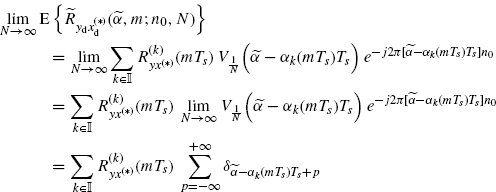
where, in the third equality, Lemma 3.10.1 is used.
In the second equality, the interchange of the limit and sum operations is justified by the Weierstrass criterium (Johnsonbaugh and Pfaffenberger 2002, Theorem 62.6; Smirnov 1964) since the series of functions of N
is uniformly convergent. In fact, by using (3.145) and Assumptions 2.4.3a and 2.4.5, we have
(3.177) 
with the right-hand side bounded and independent of N.
3.10.2 Proof of Theorem 2.6.5 Asymptotic Covariance of the Discrete-Time Cyclic Cross-Correlogram
Let us consider the covariance expression (2.186). As regards the term ![]() defined in (2.187), let
defined in (2.187), let
It results that
where ![]() is defined in (2.196) and Lemma 3.10.2 (with a ≡ b) has been accounted for.
is defined in (2.196) and Lemma 3.10.2 (with a ≡ b) has been accounted for.
The interchange of the order of limit and sum operations in (3.179) is allowed since the three-index series over (k′, k′′, ![]() ) of functions of N is uniformly convergent for the Weierstrass criterium (Johnsonbaugh and Pfaffenberger 2002, Theorem 62.6), (Smirnov 1964). In fact,
) of functions of N is uniformly convergent for the Weierstrass criterium (Johnsonbaugh and Pfaffenberger 2002, Theorem 62.6), (Smirnov 1964). In fact,
with the right-hand side independent of N, where the inequality
is used. The inequality in (3.181) follows from the fact that the sum over n is at most on 2N + 1 nonzero terms. The right-hand side of (3.180) is bounded due to Assumptions 2.4.3a and 2.4.8a. In particular, from Assumption 2.4.8a it follows that
(3.182) 
In fact, ![]() is the Riemann sum for the integral
is the Riemann sum for the integral ![]() , with the function
, with the function ![]() assumed to be Riemann integrable.
assumed to be Riemann integrable.
Analogously, it can be shown that
(3.183) ![]()
where ![]() is defined in (2.197).
is defined in (2.197).
As regards the term ![]() defined in (2.189), let
defined in (2.189), let
(3.184) 
It results that
where ![]() is defined in (2.198) and Lemma 3.10.2 (with a ≡ b) has been accounted for.
is defined in (2.198) and Lemma 3.10.2 (with a ≡ b) has been accounted for.
The interchange of the order of limit and sum operations in (3.185) is allowed since the double-index series over k and ![]() of functions of N is uniformly convergent for the Weierstrass criterium (Johnsonbaugh and Pfaffenberger 2002, Theorem 62.6), (Smirnov 1964). In fact,
of functions of N is uniformly convergent for the Weierstrass criterium (Johnsonbaugh and Pfaffenberger 2002, Theorem 62.6), (Smirnov 1964). In fact,
with the right-hand side independent of N, where the inequality (3.181) is used. The right-hand side of (3.186) is bounded due to Assumption 2.4.8b from which it follows that
(3.187) 
under the assumption that the function ![]() is Riemann integrable with respect to s.
is Riemann integrable with respect to s.
As a final remark, observe that the sum over ![]() in (3.180) is finite. In fact, a(t) has finite support [− 1/2, 1/2] and, hence,
in (3.180) is finite. In fact, a(t) has finite support [− 1/2, 1/2] and, hence, ![]() only for −2N ≤ m ≤ 2N. Consequently, in (3.180), −2N ≤
only for −2N ≤ m ≤ 2N. Consequently, in (3.180), −2N ≤ ![]() − n01 + n02 ≤ 2N. This fact, however, is not sufficient to make the right-hand side of (3.180) independent of N. Therefore, Assumption 2.4.8a needs to be exploited.
− n01 + n02 ≤ 2N. This fact, however, is not sufficient to make the right-hand side of (3.180) independent of N. Therefore, Assumption 2.4.8a needs to be exploited.
Lemma 3.10.3 Let ![]()
![]() [− 1/2, 1/2],
[− 1/2, 1/2], ![]() ≠ 0, and γ > 1. Thus
≠ 0, and γ > 1. Thus
(3.188) 
where ![]() .
.
Proof: For ![]()
![]() [− 1/2, 1/2],
[− 1/2, 1/2], ![]() ≠ 0 one has
≠ 0 one has
(3.189) 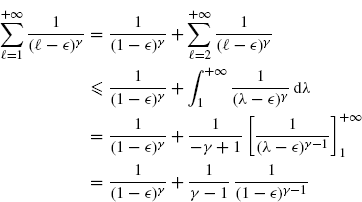
Thus,
(3.190) 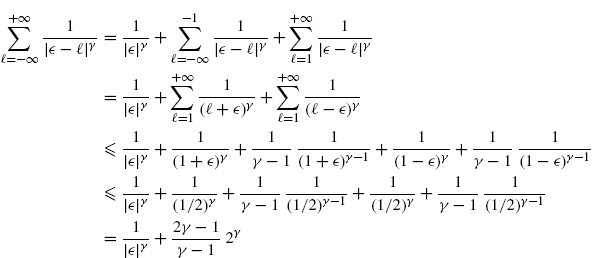
![]()
3.10.3 Proof of Theorem 2.6.7 Rate of Convergence of the Bias of the Discrete-Time Cyclic Cross-Correlogram
From (2.179b) and (2.200) it follows
(3.191) 
and from (2.183) we have
Therefore,
Let us consider the first term in the rhs of (3.192). Accounting for (2.184) we have
(3.193) 
where A(f) is the Fourier transform of a(t) and A(0) = 1 (see (3.64)). According to Assumption 2.4.5, we have |A(f)| ≤ K/|f|γ for |f| sufficiently large, say, |f| > f*. Thus, for N sufficiently large such that 2N + 1 > f* (and for | ![]() |
|![]() 1), we have
1), we have
where the sum in the third line is convergent when γ > 1. Note that in the special case of a rectangular data-tapering window a(t) = rect(t) ⇒ A(f) = sinc(f). Even if γ = 1, the result is that A(![]() (2N + 1)) = 0 for
(2N + 1)) = 0 for ![]() ≠ 0, N integer. Thus,
≠ 0, N integer. Thus, ![]() .
.
Let us now consider the second term in the rhs of (3.192).
From (2.184) we have
(3.195) 
with ![]() never equal to zero since
never equal to zero since ![]() integer when
integer when ![]() . Moreover, under Assumption 2.6.6,
. Moreover, under Assumption 2.6.6,
(3.196) ![]()
Let N be sufficiently large such that ![]() . Thus, for all
. Thus, for all ![]() and for all
and for all ![]() it results in
it results in ![]() and, hence,
and, hence,
(3.197) 
By taking ![]() in Lemma 3.10.3 (
in Lemma 3.10.3 (![]() k
k ![]() [− 1/2, 1/2),
[− 1/2, 1/2), ![]() k ≠ 0 for
k ≠ 0 for ![]() ), for every fixed
), for every fixed ![]() , m, Ts, and k one obtains
, m, Ts, and k one obtains
Thus, by using (3.194)–(3.198) into (3.192), we have
where, in the last inequality, Assumption 2.6.6 (![]() ) is used. Thus, (2.202) immediately follows.
) is used. Thus, (2.202) immediately follows.
For a rectangular lag-product-tapering window, ![]() , Kγ = 0 can be taken in (3.194), and (3.199) (with γ = 1) must be accordingly modified.
, Kγ = 0 can be taken in (3.194), and (3.199) (with γ = 1) must be accordingly modified.
For a rectangular signal-tapering window, the corresponding lag-product-tapering window ![]() has Fourier transform
has Fourier transform ![]() such that (Fact 3.5.3)
such that (Fact 3.5.3)
Thus, (3.200) and (3.199) (with γ = 1) lead to
(3.201) 
3.10.4 Proof of Lemma 2.6.9 Rate of Convergence to Zero of Cumulants of Discrete-Time Cyclic Cross-Correlograms
By using (2.181), (2.182), and the multilinearity property of cumulants we have
where, in the third equality, the variable changes nk = n and ni = n + ri, i = 1, ..., k − 1 are made, r ![]() [r1, ..., rk−1], and all the sums are finite since the function a(·) has finite support (Assumption 2.4.5). Note that the order of finite sums can be freely interchanged. From (3.202) it follows that
[r1, ..., rk−1], and all the sums are finite since the function a(·) has finite support (Assumption 2.4.5). Note that the order of finite sums can be freely interchanged. From (3.202) it follows that
where Assumption 2.6.8 is used and all the sums converge. In fact, ∑rϕ(r1Ts, ..., rk−1Ts)Ts is the Riemann sum for ![]() and ∑n|a((n − n0k)/(2N + 1))|/(2N + 1) is the Riemann sum for
and ∑n|a((n − n0k)/(2N + 1))|/(2N + 1) is the Riemann sum for ![]() . Thus, (2.206) immediately follows.
. Thus, (2.206) immediately follows.
This lemma is the discrete-time counterpart of Lemma 2.4.17 on the rate of convergence to zero of the cumulant of continuous-time cyclic cross-correlograms. Note that in the discrete-time case Assumption 2.4.16 is not used. In fact, such assumption is used in the continuous-time case in Lemma 2.4.17 to interchange the order of integrals. In the discrete-time case, as a consequence of the finite support of a(·), all the sums are finite and their order can be freely interchanged.
![]()
3.10.5 Proof of Theorem 2.6.10 Asymptotic Joint Normality of the Discrete-Time Cyclic Cross-Correlograms
From Theorem 2.6.7 holding for γ > 1 (or γ = 1 if a(t) = rect(t)) we have
(3.204) ![]()
From Theorem 2.6.5 it follows that the asymptotic covariance
(3.205) 
is finite. From Theorem 3.13.2 it follows that the asymptotic conjugate covariance is finite. Moreover, from Lemma 2.6.9 with ![]() and k
and k ![]() 3 we have
3 we have
(3.206) 
where the second equality holds since the value of the cumulant does not change by adding a constant to each of the random variables (Brillinger 1981, Theorem 2.3.1).
Thus, according to the results of Section 1.4.2, for every fixed ![]() the random variables
the random variables ![]() , i = 1, ..., k, are asymptotically (N→ ∞) zero-mean jointly complex Normal (Picinbono 1996; van den Bos 1995).
, i = 1, ..., k, are asymptotically (N→ ∞) zero-mean jointly complex Normal (Picinbono 1996; van den Bos 1995).






